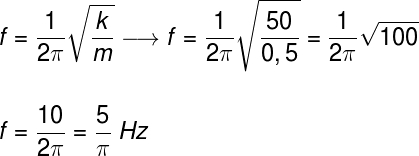O movementharmonicsimple (MHS) is a periodic movement that happens exclusively in conservative systems - those in which there is no action of dissipative forces. In MHS, a restorative force acts on the body so that it always returns to a balanced position. The description of the MHS is based on frequency and period quantities, through hourly functions of the movement.
Lookalso:Resonance – understand this physical phenomenon at once!
MHS Summary
Every MHS happens when a strength urges a moving body to return to a balanced position. Some examples of MHS are the simple pendulum it's the spring mass oscillator. In simple harmonic motion, the mechanical energy of the body is always kept constant, but its kinetic energy and potential exchange: when the energykinetics is maximum, the energypotential é minimum and vice versa.

The most important quantities in the study of MHS are those that are used to write the MHS time functions. Hourly functions are nothing more than equations that depend on time as a variable. Check out the main dimensions of the MHS:
measures the greatest distance that the oscillating body is able to reach in relation to the equilibrium position. The unit of measure for the amplitude is the meter (m);Amplitude (A):
Frequency (f): measures the amount of oscillations the body performs each second. The unit of measurement for frequency is hertz (Hz);

- Period (T): time required for the body to perform a complete oscillation. The unit of measure for the period is the second(s);
- angular frequency (ω): measures how fast the phase angle is traversed. The phase angle corresponds to the position of the oscillating body. At the end of an oscillation, the body will have swept an angle of 360° or 2π radians.

ω – frequency or angular velocity (rad/s)
Δθ – angle variation (rad)
Do not stop now... There's more after the advertising ;)
MHS Equations
Let's get to know the general MHS equations, starting with the equations of position, velocity and acceleration.
→ Position equation in the MHS
This equation is used to calculate the position of the body that develops a movementharmonicsimple:

x (t) – position as a function of time (m)
THE – amplitude (m)
ω – angular frequency or angular velocity (rad/s)
t – time(s)
φ0 – initial phase (rad)
→ Speed equation in MHS
The equation of velocity of the MHS derives from the hourly equation of the position and is given by the following expression:

→ Acceleration Equation in MHS
The acceleration equation is very similar to the position equation:

In addition to the equations shown above, which are general, there are some equations. specific, used to calculate the frequency or the time course From oscillatorsspring dough and also the pendulumsimple. Next, we'll explain each of these formulas.
Lookalso:Free fall: what is it, examples, formulas, exercises
Spring mass oscillator
At the oscillatorspring dough, a mass body m is attached to an ideal spring of elastic constant k. When removed from the equilibrium position, the elastic force exerted by the spring causes the body to oscillate around this position. The frequency and period of oscillation can be calculated using the following formulas:

k – spring elastic constant (N/m)
m – body mass
Analyzing the formula above, it is possible to notice that the oscillation frequency is proportional à constantelastic of the spring, that is, the “harder” the spring, the faster will be the oscillating movement of the spring-mass system.
simple pendulum
O pendulumsimple consists of a body of mass m, attached to a threadideal and inextensible, placed to oscillate at small angles, in the presence of a gravitational field. The formulas used to calculate the frequency and period of this movement are as follows:

g – gravity acceleration (m/s²)
there – wire length (m)
From the above equations, it can be seen that the period of movement of a pendulum depends only on the modulus of gravity place and also from the length of that pendulum.
Mechanical energy in MHS
O movementharmonicsimple it is only possible thanks to conservation of mechanical energy. Mechanical energy is the measure of the sum of energykinetics and of the energypotential of a body. In the MHS, at all times, there is the same mechanical energy, however, it expresses itself periodically in the form of kinetic energy and potential energy.

ANDM – mechanical energy (J)
ANDÇ – kinetic energy (J)
ANDP – potential energy (J)
The formula shown above expresses the mathematical sense of the conservation of mechanical energy. In an MHS, at any time, final and initial, for example, the sum of the energieskinetics and potentialéequivalent. This principle can be seen in the case of the simple pendulum, which has maximum gravitational potential energy, when the body is in extreme positions, and maximum kinetic energy, when the body is at the lowest point of oscillation.
Exercises on simple harmonic motion
Question 1) A 500 g body is attached to a simple 2.5 m pendulum and is set to oscillate in a region where gravity is equal to 10 m/s². Determine the period of oscillation of this pendulum as a function of π.
a) 2π/3 s
b) 3π/2 s
c) π s
d) 2π s
e) π/3 s
Template: letter C. The exercise asks us to calculate the period of the simple pendulum, for that we must use the following formula. Check how the calculation is done:
and according to the calculation performed, the period of oscillation of this simple pendulum is equal to π seconds.
Question 2) A 0.5 kg object is attached to a spring with an elastic constant of 50 N/m. Based on the data, calculate, in hertz and as a function of π, the oscillation frequency of this harmonic oscillator.
a) π Hz
b) 5π Hz
c) 5/π Hz
d) π/5 Hz
e) 3π/4 Hz
Template: letter C. Let's use the formula for the frequency of the spring-mass oscillator:

By doing the above calculation, we find that the oscillation frequency of this system is 5/ π Hz.
Question 3) The hourly function of the position of any harmonic oscillator is shown below:

Check the alternative that correctly indicates the amplitude, angular frequency and initial phase of this harmonic oscillator:
a) 2π m; 0.05 rad/sec; π rad.
b) π m; 2 π rad/s, 0.5 rad.
c) 0.5 m; 2 π rad/s, π rad.
d) 1/2π m; 3π rad/s; π/2 rad.
e) 0.5 m; 4π rad/s; π rad.
Template: letter C. To solve the exercise, we just need to relate it to the structure of the hourly equation of the MHS. Watch:

When comparing the two equations, we see that the amplitude is equal to 0.5 m, the angular frequency is equal to 2π rad/s, and the initial phase is equal to π rad.
By Rafael Hellerbrock
Physics teacher


